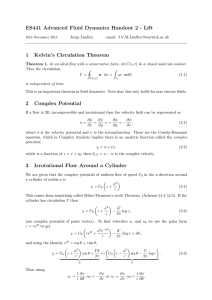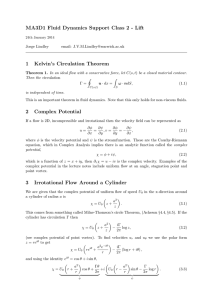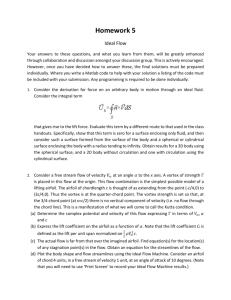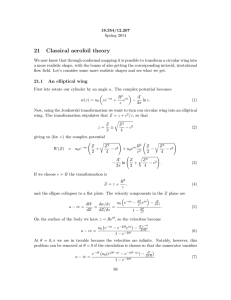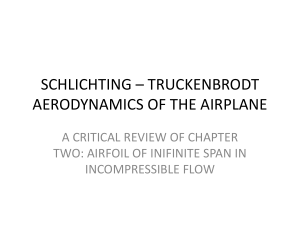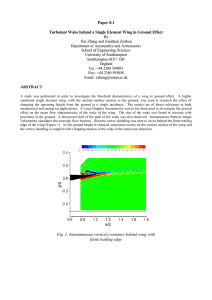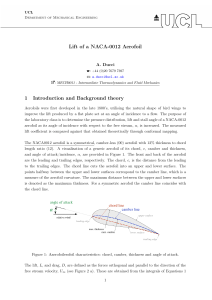MA3D1 Fluid Dynamics Support Class 3 - 2D Flows Jorge Lindley email: ebsite:
advertisement
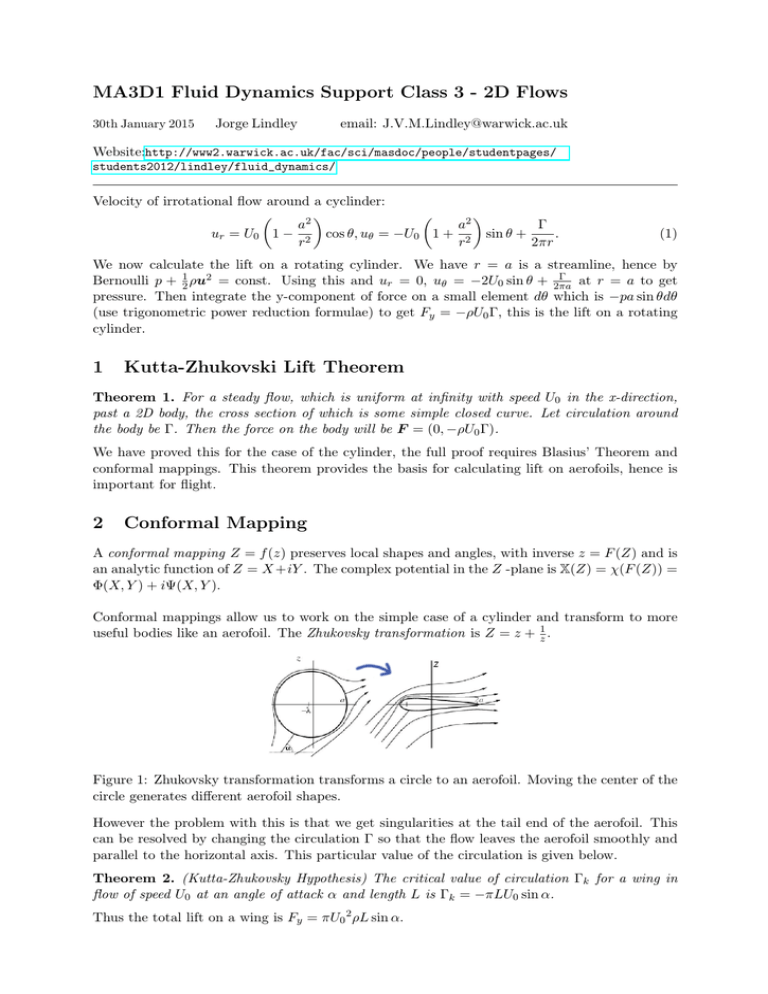
MA3D1 Fluid Dynamics Support Class 3 - 2D Flows 30th January 2015 Jorge Lindley email: J.V.M.Lindley@warwick.ac.uk Website:http://www2.warwick.ac.uk/fac/sci/masdoc/people/studentpages/ students2012/lindley/fluid_dynamics/ Velocity of irrotational flow around a cyclinder: a2 Γ a2 . ur = U0 1 − 2 cos θ, uθ = −U0 1 + 2 sin θ + r r 2πr (1) We now calculate the lift on a rotating cylinder. We have r = a is a streamline, hence by Γ Bernoulli p + 12 ρu2 = const. Using this and ur = 0, uθ = −2U0 sin θ + 2πa at r = a to get pressure. Then integrate the y-component of force on a small element dθ which is −pa sin θdθ (use trigonometric power reduction formulae) to get Fy = −ρU0 Γ, this is the lift on a rotating cylinder. 1 Kutta-Zhukovski Lift Theorem Theorem 1. For a steady flow, which is uniform at infinity with speed U0 in the x-direction, past a 2D body, the cross section of which is some simple closed curve. Let circulation around the body be Γ. Then the force on the body will be F = (0, −ρU0 Γ). We have proved this for the case of the cylinder, the full proof requires Blasius’ Theorem and conformal mappings. This theorem provides the basis for calculating lift on aerofoils, hence is important for flight. 2 Conformal Mapping A conformal mapping Z = f (z) preserves local shapes and angles, with inverse z = F (Z) and is an analytic function of Z = X +iY . The complex potential in the Z -plane is X(Z) = χ(F (Z)) = Φ(X, Y ) + iΨ(X, Y ). Conformal mappings allow us to work on the simple case of a cylinder and transform to more useful bodies like an aerofoil. The Zhukovsky transformation is Z = z + z1 . Figure 1: Zhukovsky transformation transforms a circle to an aerofoil. Moving the center of the circle generates different aerofoil shapes. However the problem with this is that we get singularities at the tail end of the aerofoil. This can be resolved by changing the circulation Γ so that the flow leaves the aerofoil smoothly and parallel to the horizontal axis. This particular value of the circulation is given below. Theorem 2. (Kutta-Zhukovsky Hypothesis) The critical value of circulation Γk for a wing in flow of speed U0 at an angle of attack α and length L is Γk = −πLU0 sin α. Thus the total lift on a wing is Fy = πU0 2 ρL sin α. 3 D’Alembert’s Paradox We have Fx = 0 ie. no drag. This contradicts the wakes in experimental observations, the reason is we have not taken viscosity into account. What happens in reality is we get vortex shedding from the wing tip. Note that the circulation of the flow around an aerofoil is zero when at rest, hence by Kelvin’s Circulation Theorem it should remain zero. In fact it does, since the circulation around the aerofoil and the trailing vortex cancel as seen in Figure 2. Vortex shedding continues until the circulation around the aerofoil reaches the Kutta-Zhukovsky value and flow leaves the aerofoil smoothly, generating lift. Figure 2: Net circulation is zero. Example 1. Airplane Lift and Trailing Vortices (a) Explain why the vortex near the wing surface (responsible for the circulation round the aerofoil) must continue into a trailing vortex through the wing tip. What is the relation between the circulation around the wing and around its trailing vortex? Answer: Near the wing surface, velocity is nearly tangential to the surface and variations are in the normal direction to the surface, so vorticity is parallel to the wing (vorticity is the curl of velocity). Vortex lines cannot end within the fluid since the velocity field is solenoidal (divergence free), ie. fluid is incompressible. They must continue beyond the wing tips which means vorticity flux remains the same. Hence the circulation around the trailing vortices is equal with opposite sign to the circulation around the wing. (b) Consider an airplane of mass M , speed V with air density ρ. Each wing is L meters long. Find the circulation around each trailing vortex. Answer: To keep the plane flying, the weight of the plane must balance the lift, so M g = ρV Γ(2L) ⇒ Γ = Mg . 2ρV L (2) (c) Assume trailing vortices originating at both wings are parallel to each other and their vorticity is concentrated in thin tubes separated by D = 2L. Find the downdraft velocity produced by these trailing vortices at the mid point between them. Answer: Velocity at midpoint is two times the velocity at a distance of D/2 from a point vortex, U= Γ 2Γ ×2= . 2π(D/2) πD (3) Example 2. Streamfunction for a 2D flow A stationary 2D incompressible (viscous or inviscid) flow is described by a stream function ψ(x, y) such that the velocity is ∂ψ ∂ψ u = (u(x, y), v(x, y), 0) = ,− ,0 (4) ∂y ∂x Show that: 1. The streamlines are given by ψ = const. 2. |u| = |∇ψ|, and conclude that the flow is faster where the streamlines are closer. 3. The volume flux (per unit length in z) crossing any curve from (x1 , y1 ) to (x2 , y2 ) is given by ψ(x2 , y2 ) − ψ(x1 , y1 ). 4. ψ = const on any fixed (i.e. stationary) boundary. 5. Find the stream function for the flow with the following velocity field, u= x2 y x ,v = − 2 2 +y x + y2 Sketch the streamlines and describe the properties of this flow. (5) Example 3. Motion of two point vortices Given information: conservation laws for the energy and momentum E=− 1 4π N X Γj Γk ln |xj − xk |, (6) j,k=1,k6=j P = (Px , Py ) = N X Γj xj . (7) j=1 Consider a system of two point vortices with circulations Γ1 and Γ2 separated by a distance d from each other at t = 0. 1. Find the distance between the vortices at t > 0. 2. Find the trajectory of each vortex for Γ1 = −Γ2 . How do the vortices move if Γ1 > 0 and Γ2 > 0? If Γ1 > 0 and Γ2 < 0? If Γ1 = Γ2 > 0? 3. Find the motion when Γ1 = −Γ2 .
